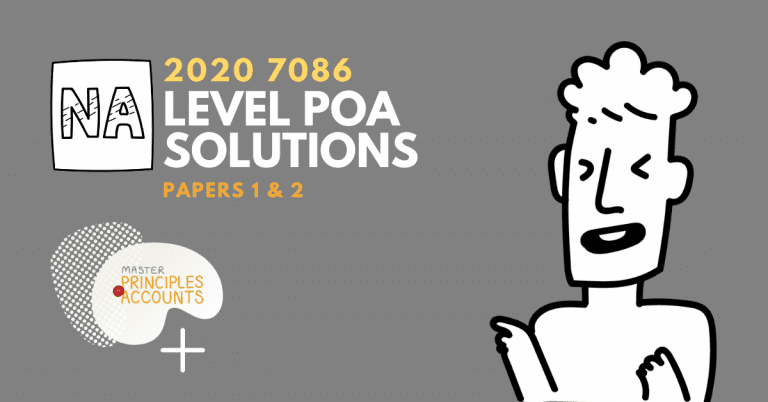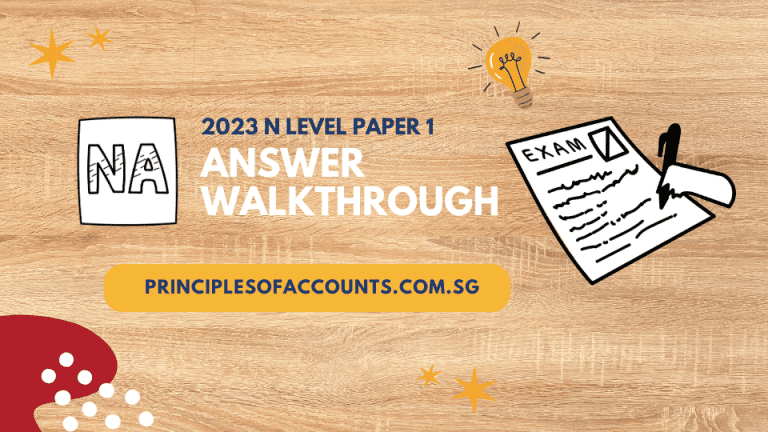2018 O Level POA Answers Paper 2
Somule Pte Limited
Statement of financial performance for the year ended 30 April 2019
| $ | $ | |
| Sales revenue | 379150 | |
| Less: sales returns | 24550 | |
| Net sales revenue | 354600 | |
| Less : cost of sales | 149900 | |
| Gross profit | 204700 | |
| Less : expenses | ||
| Interest on bank loan (35000 x 10%) | 3500 | |
| Rent (31000-6000) | 25000 | |
| Wages and salaries (86950+1350) | 88300 | |
| General expenses | 27800 | |
| Depreciation on equipment (27500×10%) | 27500 | |
| Depreciation on motor vehicles ((48000-21000)x25%) | 6750 | |
| Reversal of impairment loss on trade receivables (850-650) | (200) | |
| 178650 | ||
| Profit for the year | 26050 |
Somule Pte Limited
Statement of financial position as at 30 April 2019
| Assets | $ | $ | $ |
| Non-current asset | cost | Acc. dep. | N.B.V |
| Equipment | 275000 | 82500 | 192500 |
| Motor vehicles | 48000 | 27750 | 20250 |
| Total non-current assets | 212750 | ||
| Current assets | |||
| Inventory | 32300 | ||
| Trade receivables | 30700 | ||
| Less: allowance of impairment on trade receivables | (650) | ||
| 30050 | |||
| Prepaid rent | 6000 | ||
| Total current assets | 68350 | ||
| Total assets | 281100 | ||
| Equity and liabilities | |||
| Shareholder’s equity | |||
| Issued share capital, 300,000 ordinary shares | 150000 | ||
| Retained earnings (40625-15000+21400) | 51675 | ||
| Total equity | 201675 | ||
| Non-current liabilities | |||
| Long term borrowings (35000-5000) | 300000 | ||
| Current liabilities | |||
| Trade payables | 20900 | ||
| Short-term borrowings | 6300 | ||
| Accrued wages and salaries | 1350 | ||
| Current portion of long term borrowings | 5000 | ||
| Accrued interest on bank loan (3500-2625) | 875 | ||
| Dividends payable (300000x$0.05) | 15000 | ||
| Total current liabilities | 49425 | ||
| Total equity and liabilities | 281100 |
a) Dr sale of non-current asset
Cr motor vehicles
Dr accumulated depreciation
Cr sale of non-current asset
Dr other receivable
Cr sale of non-current asset
b) Accumulated depreciation of motor vehicles account
| Date | Particulars | Dr | Cr | Bal |
| 2016 | ||||
| Apr 1 | Balance b/d | 25600 Cr | ||
| 2017 | ||||
| Mar 31 | Depreciation (12800-25600) x 20% | 20480 | 46080 Cr | |
| Apr 1 | Balance b/d | 46080 Cr | ||
| Nov 30 | Sale of non-current asset | 10080 | 36000 Cr | |
| 2017 | ||||
| Mar 31 | Depreciation (132500 – 36000) x 20% | 19300 | 55300 Cr | |
| Apr 1 | Balance b/d | 55300 Cr |
c) Loss on sale of motor vehicle = $17900 – $14500
= $3420
d) Business charges depreciation due to normal wear and tear and obsolescence.
a) Return on equity measures the efficiency of the business in generating profit from equity.
b) 2017 2018
| Average equity | (196150 + 368550)/2 =282350 | (368550 + 563850)/2=466200 |
| Return on equity | (87400/282350) x 100%= 30.95% | (125300/466200) x 100%= 26.88% |
c) The return on equity decreased from 30.95% in 2017 to 26.88% in 2018. This shows that in (2018, Daxoq is not as efficient in using its equity to generate profit as 2017. However, comparing the percentage of dividend payout to average equity calculated in (w1) above, it has increased from 5.31% in 2017 to 6.44% in 2018. Similarly, the percentage of dividends paid to profit for the year calculated in (w2) also increased from 19.63% in 2017 to 23.94% in 2018. These show that Daxoq is paying out more dividend to shareholders per dollar of equity and from profit for the year. As business expansion usually take some times to start contributing to the business profit, the shareholders should be satisfied with the return on their investment.
d)
The difference in gross profit margin could be due to:
1) the use of many different trade suppliers by Palzo that affect his ability to buy in bulk and take advantage of trade discount
2) the use of many different trade suppliers by Palzo will also affect his ability to negotiate for a cheaper price
3) the frequent sales promotions from Palzo that lead to lower selling price
e) bankers
ai) Impairment loss on trade receivables is the estimation by the business that a trade receivable may not be able to pay.
aii) Prudence.
aiii) When the customer starts to have frequent delays in payments.
When the customer’s warehouse caught fire and all inventory was destroyed.
b) Allowance for impairment on trade receivables account
| Date | Particulars | Dr | Cr | Bal |
| 2017 | ||||
| Jun 1 | Balance b/d | 3450 Cr | ||
| 2018 | ||||
| May 31 | Trade receivables – Cheng | 3000 | 450 Cr | |
| May 31 | Impairment loss on trade receivables | 3250 | 3680 Cr | |
| Jun 1 | Balance b/d | 3680 Cr |
c)
General journal
| Date | Particulars | Dr | Cr |
| 2018 | $ | $ | |
| July 10 | Cash in hand | 1700 | |
| Trade receivables – Wesley | 1700 | ||
| Being cash received from Wesley for partial payment of debt. | |||
| July 10 | Allowance for impairment on trade receivables | 1000 | |
| Trade receivables – Wesley | 1000 | ||
| Being wrote off of balance outstanding from Wesley |
a)
| Books of Cheejun’s business | Books of Dorothy’s business |
| Account to be debited | Account to be credited | Account to be debited | Account to be credited | |
| Invoice | Dorothy | Sales revenue | Inventory | Cheejun |
| Cheque | Cash at bank | Dorothy | Cheejun | Cash at bank |
| Credit note | Sales returns / inventory | Dorothy / cost of sales | Cheejun | Inventory |
b) Cash transaction is a transaction that makes immediate payment whereas credit transaction is transaction that pays on a future date.
c) Cheque may be dishonoured due to post-dated cheque and inconsistent signature.
d) General journal
| Date | Particulars | Dr | Cr |
| 2018 | $ | $ | |
| July 9 | Cash in hand (1000 x 95% x 98% ) | 931 | |
| Discount allowed (950 x 2%) | 190 | ||
| Trade receivables – Dorothy | 950 |
e) To encourage Dorothy to buy in bulk.



